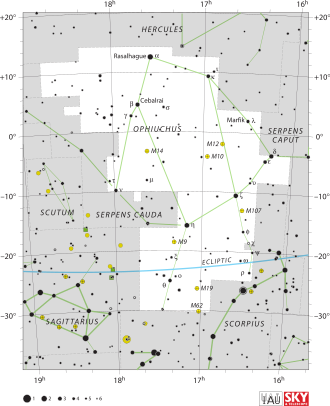GJ 1214
| Stern GJ 1214 | |||||||
|---|---|---|---|---|---|---|---|
 | |||||||
| GJ 1214 mit seinem Begleiter GJ 1214 b (künstlerische Darstellung) | |||||||
| AladinLite | |||||||
| Beobachtungsdaten Äquinoktium: J2000.0, Epoche: J2000.0 | |||||||
| Sternbild | Schlangenträger | ||||||
| Rektaszension | 17h 15m 18,93s [1] | ||||||
| Deklination | +04° 57′ 50,1″ [1] | ||||||
| Bekannte Exoplaneten | 1 | ||||||
| Helligkeiten | |||||||
| Scheinbare Helligkeit | 14,71 ± 0,01 mag [2] | ||||||
| Spektrum und Indices | |||||||
| Veränderlicher Sterntyp | BY[2] | ||||||
| B−V-Farbindex | +1,73 [1] | ||||||
| R−I-Index | +3,29 [1] | ||||||
| Spektralklasse | M4.5 V [2] | ||||||
| Astrometrie | |||||||
| Parallaxe | (68,27 ± 0,17) mas [1] | ||||||
| Entfernung | (47,75 ± 0,12) Lj (14,47 ± 0,04) pc | ||||||
| Eigenbewegung [1] | |||||||
| Rek.-Anteil: | (580,45 ± 0,48) mas/a | ||||||
| Dekl.-Anteil: | (−749,59 ± 0,22) mas/a | ||||||
| Physikalische Eigenschaften | |||||||
| Masse | (0,150 ± 0,011) M☉ [3] | ||||||
| Radius | (0,216 ± 0,012) R☉ [3] | ||||||
| Effektive Temperatur | (3026 ± 150) K [3] | ||||||
| Metallizität [Fe/H] | (0,39 ± 0,15) [3] | ||||||
| Alter | (6 ± 3) Mrd. a [3] | ||||||
| Andere Bezeichnungen und Katalogeinträge | |||||||
| |||||||
GJ 1214 (Gliese 1214) ist ein 48 Lichtjahre von der Erde entfernter Roter Zwerg im Sternbild Schlangenträger. Er besitzt rund 15 % der Sonnenmasse und ist weitaus leuchtschwächer als diese. Die Effektivtemperatur von GJ 1214 liegt bei etwa 3000 K. In einem Abstand von etwa 0,014 AE umkreist ihn GJ 1214 b, eine sogenannte Supererde.[4]
Weblinks
Einzelnachweise
- ↑ a b c d e G 139-21. In: SIMBAD. Centre de Données astronomiques de Strasbourg, abgerufen am 7. Dezember 2018.
- ↑ a b c GJ 1214. In: VSX. AAVSO, abgerufen am 7. Dezember 2018.
- ↑ a b c d e GJ 1214 b. In: Extrasolar Planets Encyclopaedia. Abgerufen am 7. Dezember 2018.
- ↑ Florian Freistetter: Die feuchte Super-Erde von GJ1214. In: Astrodicticum Simplex. 17. Dezember 2009, abgerufen am 31. Juli 2021 (deutsch).
Auf dieser Seite verwendete Medien
Autor/Urheber: ESO/L. Calçada, Lizenz: CC BY 4.0
This artist’s impression shows how the newly discovered super-Earth surrounding the nearby star GJ1214 may look. Discovered by the MEarth project and investigated further by the HARPS spectrograph on ESO’s 3.6-metre telescope at La Silla, GJ1214b is the second super-Earth exoplanet for which astronomers have determined the mass and radius, giving vital clues about its structure. It is also the first super-Earth around which an atmosphere has been found. The exoplanet, orbiting a small star only 40 light-years away from us, thus opens dramatic new perspectives in the quest for habitable worlds. The planet, GJ1214b, has a mass about six times that of Earth and its interior is likely mostly made of water ice. It appears to be rather hot and surrounded by a thick atmosphere, which makes it inhospitable for life as we know it on Earth.
Opaque red circle
Autor/Urheber: IAU and Sky & Telescope magazine (Roger Sinnott & Rick Fienberg), Lizenz: CC BY 3.0
IAU Ophiuchus chart



